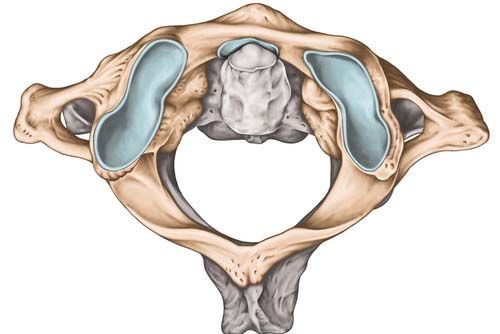One of the most common questions I get when talking with potential patients is, “What exactly is the upper cervical spine?”The upper cervical spine is actually considered the top two bones in the neck, this being the head or the skull, and then the first bone, it’s called the atlas. The first cervical vertebra is called the atlas because the atlas holds up the world, just like the first bone in your neck holds up your world, which is the head, the brain.
Then underneath is called the axis. The second cervical bone is called the axis, and the reason it’s called the axis is because when you turn your head, the first 46 degrees of motion happens between the atlas and the axis, so it’s literally the axis on which their world turns. Now, what’s significant about these two bones is, for one, the head sits on top. So anywhere these bones go, the head goes wherever those bones go. And the brainstem comes out of the head, down through the top two bones, and then from there down it becomes spinal cord.
Now, that’s very significant because the brain stem sends messages from the brain to your heart, your liver, your lungs, your kidneys, your arms, your legs, even the messages, the nerves that go up into the head, face, and neck, come down here off of the brainstem. Then they go back up through the skull to give you your vision, your taste, your smell, your hearing, and your balance. They control the sensory of the face, and the muscles of the face. All the nerves in the head, face, and neck literally come off of the neck and then go back up into the head.
The upper cervical spine is very, very important. And that’s why as upper cervical doctors, this is where we focus almost all of our attention on this area here, because it’s so vital to the rest of the body. Now, from a standpoint of musculoskeletal issues, wherever these bones go, the head must go wherever those bones take it. Well, you have something within your brain, it’s called the righting and reflex, and the whole purpose is to make sure the brain is always level or parallel to the ground. If one of the bones in the top of the neck throw the head off even just a little bit, the brain doesn’t like it.
The brain responds by sending messages down, forcing your body now to compensate until the head levels again. To give you an example, let’s say for me the bone went to my right, your left, and it took the head a little bit that way, now the brain’s off balance, righting reflex kicks in. From there, it might cause me to drop one shoulder and raise one hip, and it’s going to contort my spine, my skeletal system till that brain levels again. It has to because the brain has to be level. Now that creates weaknesses within the spine.
Over time, those weaknesses can turn into neck pain or headaches. They can affect the nerves at the disc level that go down the arms to the hands, and they cause upper back pain, lower back pain, and even pain down into the legs. Now when that throws everything out of balance, now your hips are out of balance, and now your legs or one leg becomes a little shorter than the other. Over time, this can cause your hips to wear down prematurely, cause your knees to wear down prematurely, and even your feet and your ankles.
On top of that, the brainstem we talked about sends all the messages, so if the bone gets out of alignment it can interfere with the message to your heart, your stomach, your kidneys, your arms, and your legs. If the brain doesn’t get the full message to that part of the body, it doesn’t work the way it’s intended. As a result, you can have organic problems as well. Digestive issues, sleep problems, energy, immune function all can happen from just something being out of alignment at the top of the neck.
Now, as far as saying, “But I don’t have any neck pain.” Well, the strange thing about the brainstem, the central nervous system, brain, brainstem, spinal cord, is that it doesn’t have any pain perception. You could have had a bone out of alignment at the top of your neck for years without having any kind of neck pain or headaches, but it can be interfering with the messages that go to one or multiple parts of your body. It could have thrown your body out of balance, creating weaknesses that now are affecting your knees, or your hips, or your back. It’s worthwhile to have this area investigated.
Find an upper cervical doctor near you and let them go in and check you. Within just a few minutes, we can usually determine whether you might have a problem here that could be affecting your health in a negative way. If you do, we’ll explain to you what we need to do to try to fix it. If you do not, hey, at least you ruled that out. We promise we’ll try to find another specialist that we believe that can help you.

